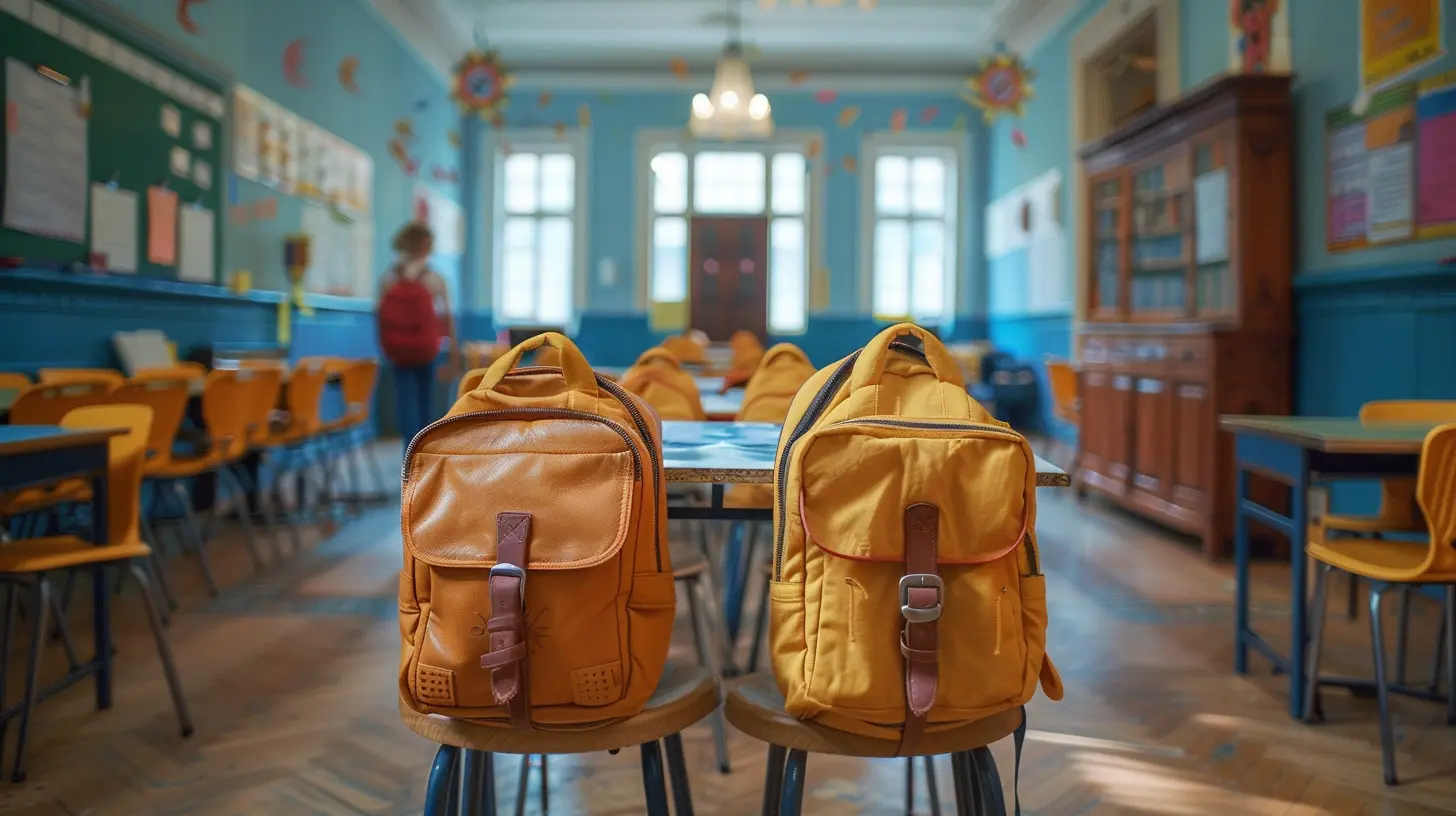23 February 2025
Bullying is a pervasive issue in schools worldwide. It’s a topic that sparks concern among parents, educators, and students alike. But here's the thing—just having anti-bullying policies isn't enough. So, what’s the missing piece? School climate.
The climate of a school can either encourage or deter bullying. Think of it like the weather. If the climate is warm, kind, and supportive, students are more likely to thrive. If it's harsh, chilly, and full of tension, problems like bullying are more likely to take root. In this article, we’ll dive into the importance of school climate in bullying prevention, and how a positive school environment can make all the difference.

What Is School Climate?
Before we get into the nitty-gritty of how school climate relates to bullying, let's break down what school climate actually means.School climate refers to the quality and character of school life. It’s essentially the "vibe" you get when you walk through the doors. It's about the relationships between students, staff, and teachers. It’s about whether students feel safe, respected, and supported—or whether they feel isolated and fearful.
A healthy school climate promotes:
- Emotional and physical safety
- Respect and inclusivity
- Positive relationships among peers and staff
- Engagement in learning
- Fair and consistent discipline policies
In contrast, a negative school climate might be one where there's little trust, communication is weak, and students feel neglected or even targeted.

How Does a Positive School Climate Prevent Bullying?
Now that we’ve got a sense of what school climate is, why does it matter for bullying prevention?1. Promoting a Sense of Belonging
Let’s face it—nobody wants to feel like an outsider. A positive school climate works to make every student feel like they belong. When students feel connected to their school and peers, they’re less likely to engage in bullying behavior or be targeted by others. It’s like being part of a team. If everyone’s working together towards a common goal, there’s less motivation to tear anyone down.Feeling like you belong can significantly reduce bullying incidents. Students who feel valued and included are less likely to lash out or feel inclined to bully others. The more connected students feel, the less likely they are to create conflict.
2. Fostering Open Communication
Imagine a school where students are afraid to speak up. Bullying thrives in silence. In a positive school climate, students feel comfortable reporting bullying, knowing that their concerns will be taken seriously.When communication channels between students, teachers, and staff are open, bullying behavior is identified and addressed quickly. Everyone knows that bullying isn’t tolerated, and victims don’t have to suffer in silence.
Open communication also encourages bystander intervention. In a supportive environment, students are more likely to step in or report bullying when they see it happening. In contrast, in a negative school climate, bystanders may remain passive out of fear that they’ll become the next target.
3. Encouraging Empathy and Respect
Empathy plays a huge role in preventing bullying. When students are taught to understand and respect each other’s differences, they’re less likely to engage in hurtful behavior. A positive school climate actively promotes values like kindness, respect, and understanding.Think of it like a garden. If you plant seeds of empathy, you’re going to grow a community where students are more mindful of each other’s feelings. Without empathy, bullying can spread like weeds. Schools that cultivate a climate of respect are directly tackling the root causes of bullying.
4. Providing Emotional and Social Support
Bullying doesn’t happen in isolation. Often, bullies act out because they’re dealing with their own issues, whether it’s trouble at home, low self-esteem, or difficulties in school. A positive school climate recognizes that students have emotional needs and provides support systems to meet those needs.This is where counselors, social workers, and peer support groups come into play. When students know they have a trusted adult or peer to turn to, they’re less likely to resort to bullying as a coping mechanism. Plus, students who receive emotional support are less vulnerable to becoming victims of bullying.
5. Fair and Consistent Discipline Policies
How a school handles discipline can make or break its climate. If students see that bullying is met with inconsistent consequences, they may feel like the rules don’t apply to everyone equally. This can lead to more bullying, as bullies may feel emboldened to act without fear of repercussions.In a positive school climate, discipline policies are clear, fair, and consistently applied. Everyone understands the consequences of bullying, and there’s no sense of favoritism or bias. This fairness promotes a sense of justice and safety, deterring students from engaging in bullying behavior.

The Role of Teachers in Shaping School Climate
Teachers play a pivotal role in creating a positive school climate. They’re on the front lines, interacting with students daily. A teacher’s attitude can have a huge impact on the overall climate of a school.1. Modeling Positive Behavior
Teachers set the tone for behavior in the classroom. When teachers model kindness, respect, and empathy, students are more likely to follow suit. It’s like setting an example—students are watching, and they’ll mirror what they see.By treating students with respect and handling conflicts in a calm, fair manner, teachers can show students how to behave in difficult situations. This helps to create a classroom atmosphere where bullying is less likely to occur.
2. Creating Inclusive Classrooms
Bullying often targets students who are perceived as “different.” Creating an inclusive classroom where diversity is celebrated can prevent this kind of targeting. Teachers can foster inclusivity by:- Encouraging group work that mixes different students
- Promoting discussions about diversity and acceptance
- Ensuring that all students have a voice in the classroom
When students feel included and accepted, they’re less likely to be bullied or bully others.
3. Building Strong Relationships with Students
Teachers who take the time to build strong relationships with their students are in a better position to notice signs of bullying. When students feel comfortable talking to their teachers, they’re more likely to report bullying or seek help when they need it.Building relationships isn’t just about academics. It’s about taking an interest in students’ lives, listening to their concerns, and showing that you care about their well-being. This creates an environment of trust and safety, which is essential for bullying prevention.

The Role of Students in Shaping School Climate
It’s not just up to teachers and staff to create a positive school climate. Students also play a huge role. After all, they’re the ones who experience the climate most directly. So how can students contribute to a bully-free environment?1. Being Upstanders, Not Bystanders
One of the most powerful tools in bullying prevention is bystander intervention. When students stand up against bullying, they send a clear message that it’s not acceptable.But being an upstander doesn’t always mean confronting the bully directly. It can be as simple as:
- Offering support to the victim
- Reporting the incident to a teacher or staff member
- Spreading kindness and inclusion in day-to-day interactions
When students take a stand against bullying, it changes the dynamic of the entire school.
2. Engaging in Peer Support
Peer support programs are an excellent way to create a sense of community and prevent bullying. These programs connect students with each other, offering a safe space to talk about their experiences and feelings.When students support each other, they help build a positive school climate where bullying has no place. Programs like peer mentoring or “buddy systems” can be especially effective in fostering connections between students who might otherwise feel isolated.
How Can Schools Improve Their Climate?
So, what can schools do to create a climate that prevents bullying? Here are some strategies:1. Conduct School Climate Surveys
One of the first steps in improving school climate is to understand where the school currently stands. Schools can conduct climate surveys to assess how students and staff feel about their environment. These surveys can highlight areas that need improvement and help schools create targeted interventions.2. Provide Training for Teachers and Staff
Teachers and staff need to know how to recognize and respond to bullying. Schools can provide professional development opportunities focused on building positive school climates and preventing bullying. This training can help staff better understand how to manage conflicts, promote inclusivity, and support students.3. Implement Social-Emotional Learning (SEL) Programs
Social-emotional learning (SEL) programs teach students important skills like empathy, emotional regulation, and conflict resolution. These programs can help create a positive school climate by promoting healthy relationships and reducing the likelihood of bullying.4. Create Safe Spaces
Designated safe spaces—whether they’re physical rooms or designated times for peer support groups—can give students a place to go when they need help. These spaces can be a lifeline for students who feel isolated or bullied.Conclusion
The importance of school climate in bullying prevention cannot be overstated. A positive school climate fosters a sense of belonging, promotes open communication, encourages empathy, and provides support systems for emotional and social needs. By focusing on the overall environment, schools can significantly reduce bullying and create a safe space for all students to thrive.Teachers, students, and staff all play a role in shaping this climate. Through collaboration and a shared commitment to kindness, respect, and inclusivity, we can create schools where bullying is simply not part of the equation.












Kendall Riggs
Creating a positive school climate isn’t just a feel-good initiative; it's the bedrock of effective bullying prevention. When students feel safe and valued, empathy flourishes, and bullying diminishes. Let’s prioritize the atmosphere!
April 8, 2025 at 1:00 PM